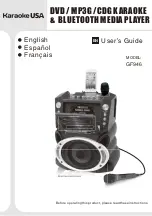
Page 17
Copyright © 2005 - ASR Electronics. All rights reserved.
Normally I encourage people to run some tests before reassembling these kind of things, but unfortunately
we’re not in a position to be able to in this case. What we can do instead is to double – and even triple –
check all our work. Make certain all the connections to the base PCB are the RIGHT ones. There are a lot
of vias around the area, make sure you connected to the correct ones. Make sure you clip the excess wires
from both PCBs when you’ve finished the soldering, and make sure those off-cuts didn’t fall inside the unit
to short something out. Pick up the base unit and give it a good shake, even use a clean paintbrush to
brush any debris out. If you have an air compressor, all the better – give it a blast with the nozzle to blow
out anything which might cause problems down the track.
When you’re satisfied that it’s all OK, you can go ahead and reassemble the head unit. It’s basically the
reverse sequence of the stripdown. This is where the single player guys actually have the advantage – just
re fit the top half of the chassis, reconnect the plug to the CD drive mechanism, and screw it back in. With
the six-stacker, firstly make totally sure that the connector is UNLOCKED. Getting the ribbon cable back in
here can be a challenge, but be patient. Note that during the attempt to slide the ribbon back into the
connector you might inadvertently re-engage the lock – make sure you haven’t done this. It’s virtually
impossible to insert the ribbon when the connector is even partially locked. When the ribbon is properly
engaged in the connector there should only be about a 1.5mm width of the ribbon’s tinned contacts visible,
and it needs to be square to the connector. When it’s seated correctly slide the lock tabs to the “locked”
position, and make sure both ends of the locking tab are in place. Replace the side screws, and return the
bottom cover plate and the two screws associated with it.
Now the facia goes back on, but here’s another trick – sometimes it doesn’t want to sit back properly
against the chassis. Well, along the top and bottom edge of the facia there’s a slit about 1mm wide – on the
front edge of the top and bottom cover plates there are small “tabs” poking out. If these aren’t quite in
alignment when you put the face back on, the tabs don’t go into the slot. Wriggle things a little, or even
encourage the tabs to drop into place with a jeweller’s driver, but once they line up OK the front panel goes
straight back on. Oh, don’t forget to plug the connector back in first!
Now it’s time to finish the work on the cradle. Slide the reassembled head unit into the cradle, and make
certain that the slot is in the correct position so the receptacles in the socket are central. (refer to the photo.
Note that these photos show an output only installation – the input mod occupies the additional connection
points)
Now take the lead-out cable assembly and insert the pins into the socket. Hold the board down firmly
against the back panel, and if you have a “pin vice” use a 1mm bit to mark the hole position on the cradle
through the PCB as I have in the photo. If you don’t have a pin vice, you could use your cordless drill with a
1.5 or 2mm bit. Don’t drill right through though, for obvious reasons – we just need a starting point for the
holes. Make certain that the head unit is sitting firmly against the bottom surface of the cradle – it can “sit
up” a little when the unit is placed face down.
This part of the job MUST be done accurately - If the holes for the mounting screws end up in the
wrong position, you won’t be able to get the head unit back into the cradle!


































